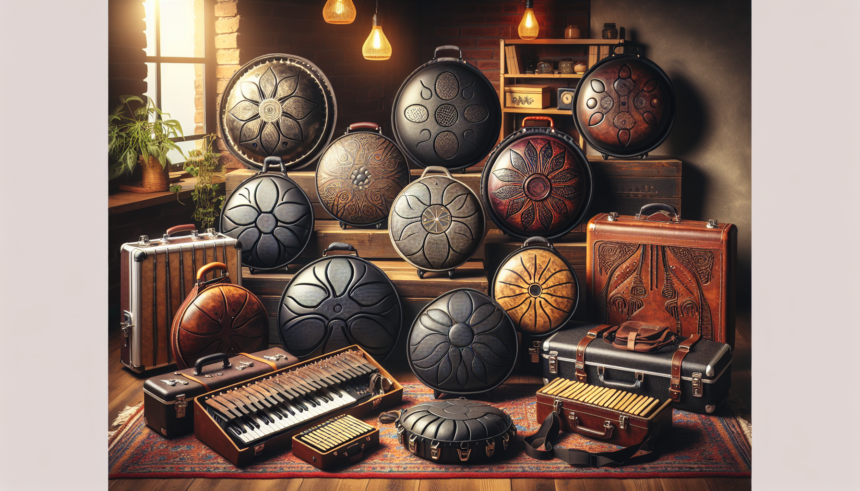<!DOCTYPE html>
<html lang="en">
<head>
<meta charset="UTF-8">
<meta name="viewport" content="width=device-width, initial-scale=1.0">
<title>Aesthetic and Functional: Stylish Handpan Cases for Every Musician</title>
<style>
body {
font-family: Arial, sans-serif;
line-height: 1.6;
color: #333;
margin: 0;
padding: 0;
}
.container {
width: 80%;
margin: 0 auto;
padding: 20px;
}
h2 {
color: #2c3e50;
}
p {
margin: 10px 0;
}
.faq {
background: #f4f4f4;
padding: 15px;
margin: 20px 0;
border-radius: 5px;
}
.faq h3 {
margin-top: 0;
}
</style>
</head>
<body>
<div class="container">
<h2>Introduction</h2>
<p>The handpan, with its ethereal sound and captivating design, has captured the hearts of musicians worldwide. Originating in the early 2000s, this unique instrument has become a prominent symbol of music's meditative and expressive power. However, for many handpan owners, transporting this precious instrument poses a challenge. How can they ensure its safety while also showcasing their style? The solution lies within the world of handpan cases, where aesthetic meets function seamlessly.</p>
<h2>The Importance of a Good Handpan Case</h2>
<p>For any handpan musician, the instrument is not just a piece of metal; it's a companion on a musical journey. Protecting such a valuable piece involves more than just padding. A good handpan case provides the essential shield against physical damage, environmental hazards, and the everyday wear and tear that comes with being a traveling musician.</p>
<p>Beyond protection, the case also needs to support the musician's style, convenience, and often a bit of personal flair. Balancing these elements—protection, convenience, style—is key in choosing the right handpan case.</p>
<h2>Functional Aspects of Handpan Cases</h2>
<p>When considering functionality, a few critical aspects come into play. Firstly, the sturdiness of a handpan case is paramount. The ideal case should be robust enough to withstand accidental bumps or drops. This durability often stems from quality materials such as reinforced fabrics, sturdy plastics, or even carbon fiber for high-end models.</p>
<p>Additionally, a handpan case needs to offer ample padding. Quality padding not only cushions the handpan but also absorbs shock during impact, effectively safeguarding the instrument's delicate structure. Cases with adjustable padding allow musicians to secure their handpans snugly, regardless of slight variations in size among different handpan brands.</p>
<p>Beyond protection, the case should be lightweight and easy to carry. Handpans are heavier than many musical instruments, often ranging from 5 to 10 kilograms. A lightweight case with comfortable carry options such as padded handles and adjustable shoulder straps can drastically ease the burden of transport.</p>
<h2>Aesthetic Appeal of Handpan Cases</h2>
<p>The aesthetic aspect of a handpan case involves its design, color, and material choice. A case that appeals to a musician's personal style often becomes an expression of their musical identity. From sleek, modern designs to vibrant, colorful patterns, the variety available ensures that musicians can find a case that resonates with them visually.</p>
<p>Material choice plays a significant role in the case's aesthetic appeal. Leather, for instance, offers a classic, timeless look, while synthetic options may cater to those seeking modern or eco-friendly alternatives. Additionally, some cases incorporate decorative elements or unique textures, further enhancing their visual allure.</p>
<p>The color palette is another vital element. Whether a musician prefers subdued, neutral tones or bold, eye-catching colors, there's a case to match their preference. Personalization options such as monograms or decals allow musicians to make the case uniquely their own.</p>
<h2>Exploring Different Styles of Handpan Cases</h2>
<p>The market for handpan cases has expanded significantly, offering a vast array of styles to suit various tastes and needs. Backpack-style cases are a popular choice, especially among street performers and traveling musicians. These cases often include ergonomic designs that distribute the instrument's weight evenly, minimizing strain during transport.</p>
<p>Semi-rigid cases serve musicians who prioritize protection while still maintaining some flexibility in design. These typically feature a hard shell exterior with soft, cushioned interiors, offering a balance between sturdiness and style.</p>
<p>For those who seek maximum protection, hard cases made from materials like plywood or plastic provide extensive safeguarding against potential damage. With their rugged designs and often enhanced security features such as lockable zips, hard cases are ideal for musicians with extensive travel or rigorous performance schedules.</p>
<p>Traditional hand-woven or handcrafted cases bring in a cultural aspect, often appealing to musicians who appreciate artisanal craftsmanship. These cases stand out with their intricate designs and can even serve as conversation starters.</p>
<h2>Functional Add-ons and Features</h2>
<p>As with any musical accessory, advancements in design have introduced several functional features that enhance the utility of handpan cases. Many models now include external pockets or compartments, perfect for storing music sheets, tuning devices, or personal belongings.</p>
<p>Water-resistant or waterproof cases cater to musicians who frequently perform outdoors, ensuring their handpan remains dry and unharmed during unexpected weather changes. Some advanced designs incorporate climate control features, maintaining optimal humidity levels within the case to preserve the handpan's tune.</p>
<p>The integration of these additional features often comes down to understanding the specific needs of the musician. Travel-focused cases may emphasize security features such as TSA-approved locks, while locally performing artists might prioritize convenience and comfort.</p>
<h2>Choosing the Right Case for Your Handpan</h2>
<p>Selecting the right case involves considering several factors, starting with the musician's lifestyle and performance setting. A street performer would demand different features compared to a studio musician. Assessing what the handpan player prioritizes in terms of protection, portability, and aesthetics will significantly narrow down the options.</p>
<p>Budget is naturally a consideration, but it shouldn't compromise the quality required for adequate protection. Musicians should aim to invest in a case that balances cost with the necessary features, understanding that a protective, durable case is an investment in their instrument's longevity.</p>
<p>Finally, it could be worthwhile to explore reviews and professional recommendations. User experiences often provide insights into the practical advantages and potential drawbacks of various models, helping musicians make informed choices.</p>
<h2>Conclusion</h2>
<p>Stylish handpan cases perfectly embody the blend of aesthetic appeal and functional necessity. With a diverse range available, every musician can find protection for their instrument while also reflecting their personal taste and lifestyle. As the demand for handpans continues to grow, the variety and innovation in case designs promise to enhance the journey for every musician, from casual hobbyists to seasoned performers.</p>
<p>Ultimately, the right handpan case does more than just safeguard a valuable instrument—it complements the musician's identity and contributes to the overall musical experience. By choosing a case that aligns with their practical needs and aesthetic preferences, musicians can focus on creating beautiful sounds with peace of mind.</p>
<div class="faq">
<h3>Frequently Asked Questions</h3>
<p><strong>1. Can I use any soft gig bag for my handpan?</strong></p>
<p>While some gig bags might fit a handpan, they often lack the necessary protection against damages. It's best to choose a case specifically designed for handpans to ensure it offers adequate cushioning and support.</p>
<p><strong>2. What's the best material for a handpan case?</strong></p>
<p>The "best" material depends on your needs. If you want lightweight with good protection, consider reinforced fabrics. For maximum protection, hard plastic or carbon fiber might be ideal.</p>
<p><strong>3. Are handcrafted cases durable?</strong></p>
<p>Handcrafted cases can be very durable if made with high-quality materials. However, their protective qualities can vary significantly, so it's essential to ensure that they have adequate padding and construction.</p>
<p><strong>4. Do waterproof cases also prevent humidity-related damage?</strong></p>
<p>Waterproof cases prevent liquid damage, but they don't necessarily control humidity. Look for cases with climate control features for protection against humidity changes.</p>
<p><strong>5. How often should I replace my handpan case?</strong></p>
<p>Replacement largely depends on wear and tear. Regular use and exposure to harsh conditions might necessitate replacement every few years. Inspect your case regularly to ensure it maintains its protective qualities.</p>
</div>
</div>
</body>
</html>Aesthetic and Functional: Stylish Handpan Cases for Every Musician

Leave a comment




